If you are looking to start your eCommerce journey, then there are quite a few Content Management Systems (CMS) in the industry.
Among the popular CMS platforms, WordPress and OpenCart are two of the best CMS platforms and we are going to make a detailed OpenCart vs WordPress for eCommerce comparison.
WordPress started out as a blogging platform back in 2003 by Matthew Charles Mullenweg. With its amazing functions and plugins, you can turn your WordPress blogging platform into a real live eCommerce platform.
OpenCart was started back in 2010 by Daniel Kerr and quickly became one of the most popular platforms for creating an eCommerce store. The platform offers everything that a user needs to create an online store.
Today we will dig deep and find all the differences and similarities between WordPress and OpenCart and help you choose the best one for your dream online store.
Let’s start with-
OpenCart vs WordPress: Short Overview
Before we go into the features and functionalities, let’s get a short overview of both platforms. Starting with-
What is OpenCart ?
OpenCart is an open source platform that works with PHP and MySQL. That platform has a powerful store management system, a host of extensions and themes, a great support system that help users manage their online store.
The current market share of OpenCart is 0.3% and more than 3000 websites are using Opencart to build their eCommerce website in the top 1 million websites.
What is WordPress?
WordPress is an open-source CMS that helps users write, publish and manage a lot of content. You can variety of websites including blogs, e-commerce stores, business websites, and portfolios.
The current market share of WordPress is 43.2%, making it the biggest CMS platform in the world. If we look at websites that are created with CMSs, that number is even higher: 63.1%!
Now let’s see the main differences and similarities of OpenCart vs WordPress for eCommerce.
OpenCart vs WordPress for eCommerce: Key Features, Similarities & Differences
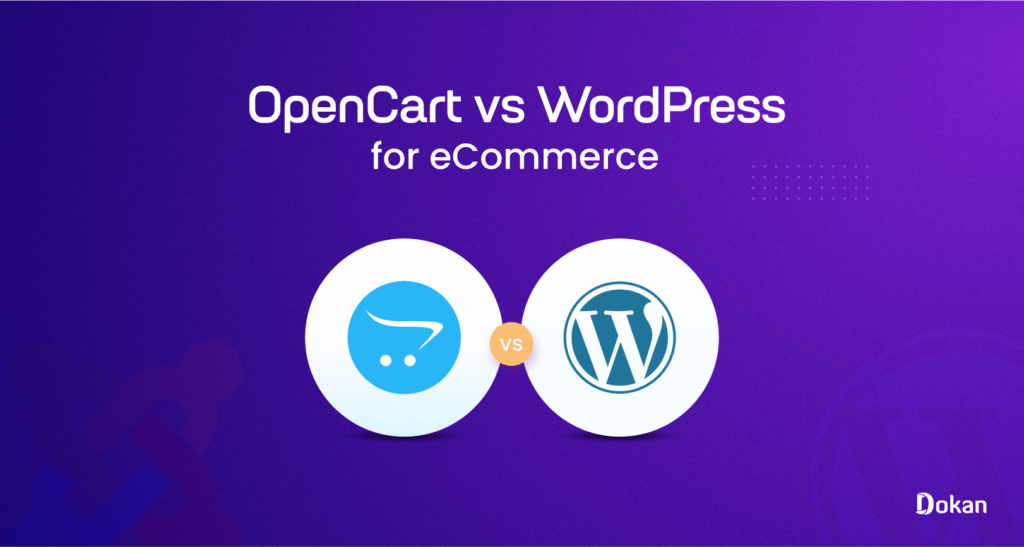
Both OpenCart and WordPress are popular players in the eCommerce industry. However, there are a few differences along with some similarities in their functions and functionalities.
Here are the points we are going to cover-
- Ease of Use and Interface
- Design and Personlization
- Apps and Extensions
- Shipping
- Tax
- Payment Gateways
- Security & Backup
- Product & Order Management
- Marketing & SEO
- Help and Support
- Pricing
Let’s start with-
Ease of Use and Interface
Let’s talk about how easy it is to use both of the platforms.
OpenCart
OpenCart has a straightforward setup. But you need to be familiar with the FTP system. You will need to download OpenCart, unzip it, upload the Upload folder to your web host using FTP, and manually set up a MySQL database.
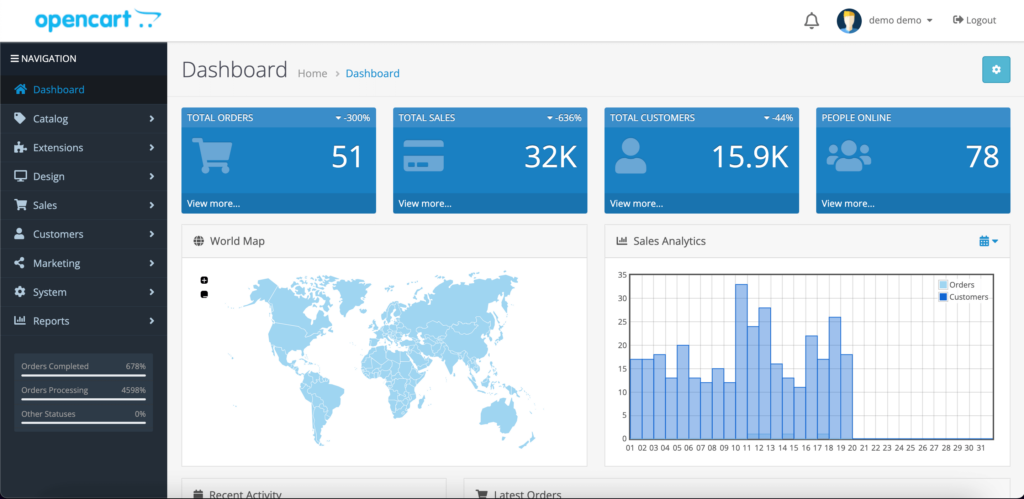
While that might sound complicated, it is actually quite straightforward and OpenCart has good documentation to walk you through it.
You will get a powerful admin dashboard, unlimited listing options, user management, and payment gateways.
WordPress
With WordPress, you have to get your own domain and hosting. But with most of the hosting providers, you can get WordPress installed with only one or a few clicks.

After installing WordPress, you will get a detailed dashboard. From the dashboard, you can install plugins including WooCommerce, which turns your WordPress site into an eCommerce store. You can install an eCommerce theme to give your site a premium look.
You don’t need to worry about creating the necessary pages like a cart page, or checkout page. WooCommerce automatically creates these pages.
Design and Personlization
Both OpenCart and WordPress have templates and themes that help give users a professional look to their eCommerce store.
OpenCart
You will find all the themes and templates in the OpenCart marketplace. When you install OpenCart, you will get a basic design. You can add themes from the OpenCart marketplace.
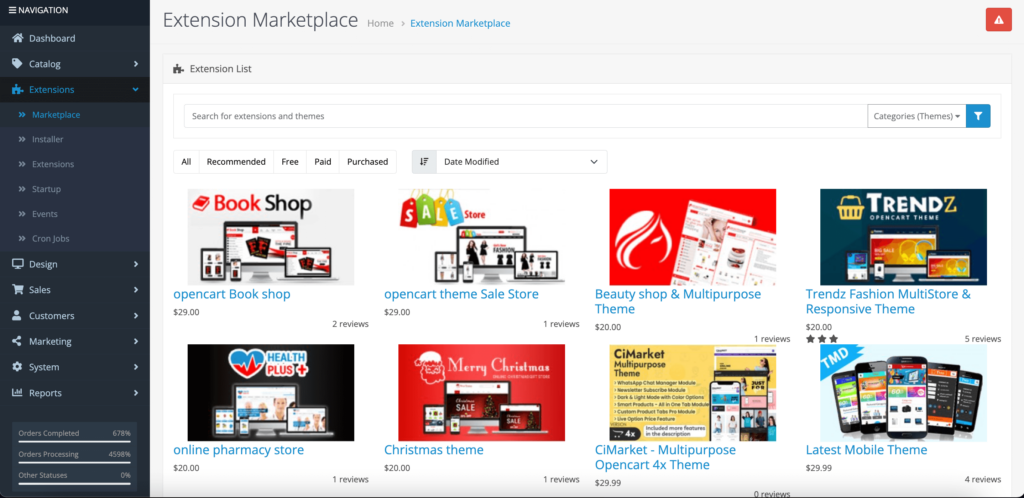
You will need HTML and CSS skills to customize these themes. Or you can hire a developer to customize the themes.
Apps and Extensions of OpenCart
OpenCart also comes with several useful extensions, which you can buy from the OpenCart marketplace on their website or other marketplaces. There are enough to allow you to run your store smoothly.
WordPress
WordPress will give you endless customization. It has free and premium themes. You will find thousands of themes in the WordPress repository and they are organized categorically. You just need to search with the right term (in your case “eCommerce”) and you can choose from all the beautiful themes available.
There are more than 2200+ eCommerce themes available to download and purchase.

Other than there are quite a few page builders available for WordPress. You can use page builders like Elementor, Divi, Oxygen, and Gutenberg to design and customize your online store.
Plugins and Extensions of WordPress
You can use the WooCommerce plugin to turn your WordPress website into an eCommerce store. You can also use the Easy Digital Downloads to add eCommerce functionalities to WordPress. But we are going to emphasize WooCommerce.
There are 60000+ plugins available in the WordPress repository that you can use to enhance your online store.
You will find plugins for SEO, Booking, Auctions, Analytics, Shipping, Subscriptions, etc. Most of these plugins are compatible with WooCommerce
Shipping
Shipping is an important part of any eCommerce store. OpenCart and WordPress both have extensive shipping features.
So we will discuss the shipping options in this OpenCart vs WordPress for eCommerce comparison.
OpenCart
OpenCart has shipping features that allow store owners to offer different shipping methods to their customers. OpenCart has the following shipping methods:
- Flat rate: This method charges a fixed shipping rate, regardless of the weight or size of the order.
- Free shipping: This method offers free shipping to customers.
- Weight-based: This method calculates the shipping rate based on the weight of the order.
- Per item: This method calculates the shipping rate based on the number of items in the order.
- Total-based: This method calculates the shipping rate based on the total value of the order.
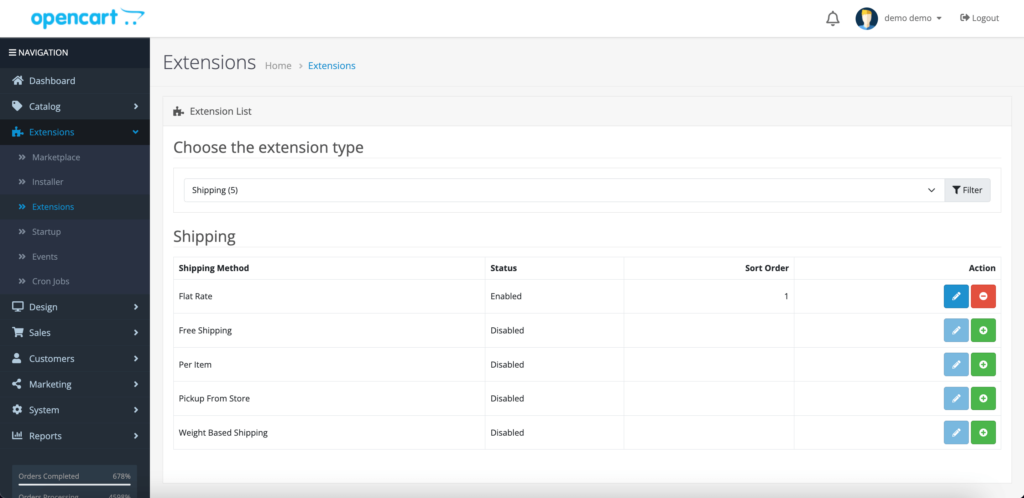
You can also add additional shipping methods to their store by installing extensions from the OpenCart Marketplace. These extensions can offer a variety of features.
WordPress
WordPress, shipping functionalities come from the WooCommmerce plugin. You can find the shipping options from the WordPress dashboard under the WooCommerce settings options.

You are able to set shipping rates by region and choose different shipping methods for those regions. In the free version of WooCommerce, you can set various shipping types-
- Free shipping
- Flat rate
- Local pickup.
If you want more advanced shipping options then you can install the WooCommerce Table Rate shipping extension.
Tax
OpenCart and WordPress both offer tax options. let’s see the differences and similarities between these two regarding taxes-
OpenCart
The OpenCart tax feature allows store owners to charge taxes on orders. the OpenCart includes the following tax types:
- Fixed: This tax type charges a fixed amount of tax, regardless of the total value of the order.
- Percentage: This tax type charges a percentage of the total value of the order as tax.
- Progressive: This tax type charges a different tax rate on different portions of the order, based on the total value of the order.
You can also add additional tax types to their stores by installing extensions from the OpenCart Marketplace. These extensions can offer a variety of features, such as tax integration with popular tax authorities, as well as more advanced tax options, such as tax exemptions and tax rules.
WordPress
With WordPress, you can add standard tax rates, reduced tax rates, and zero tax rates based on the country and its tax rules. The tax feature comes from the WooCommerce and the tax feature includes-
- Automatic tax calculation
- Manual tax calculation
- Tax rates:
- Tax exemptions
- Tax reports.
Payment Gateways
OpenCart and WordPress both offer integrations with different types of payment gateways. We are going to look into that-
OpenCart
OpenCart payment gateways are extensions that allow store owners to accept payments from customers through a variety of payment processors. Some of the most popular OpenCart payment gateways include:
- PayPal
- Stripe
- Authorize.net
- Braintree
- Amazon Pay
- Square
- 2Checkout
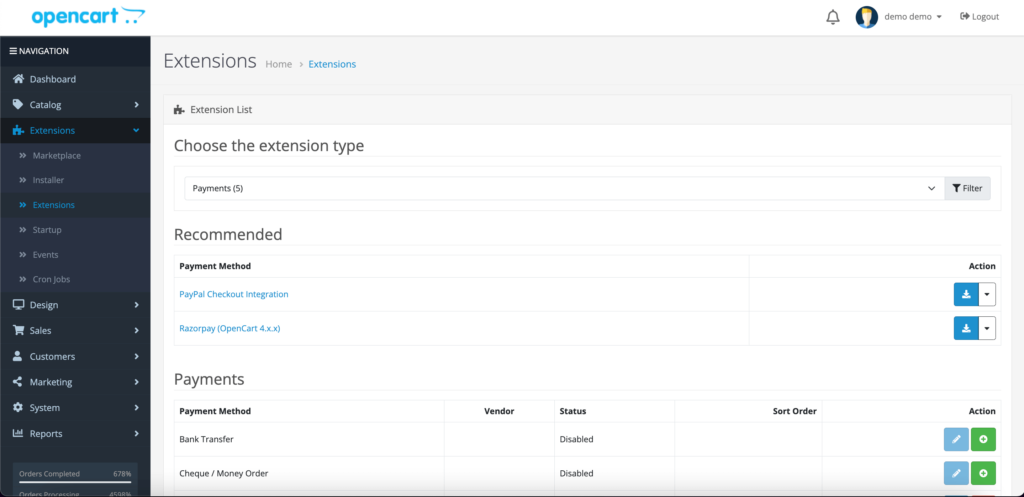
These payment gateways offer a variety of features, such as support for major credit and debit cards, digital wallets, and bank transfers. They also offer fraud protection and other security features.
To install an OpenCart payment gateway, store owners can go to the OpenCart Marketplace and search for the payment gateway that they want to use.
WordPress
WooCommerce has integration with all the major payment gateways including, Paypal, Stripe, Wirecard, Google Pay, Apple Pay, etc. Also, you can use the WooCommerce Paymnets plugin to accept credit cards, debit cards, and other popular payment methods.
However, there are other payment options you can configure like-
- Check payments
- Cash on delivery
- Direct bank transfer.
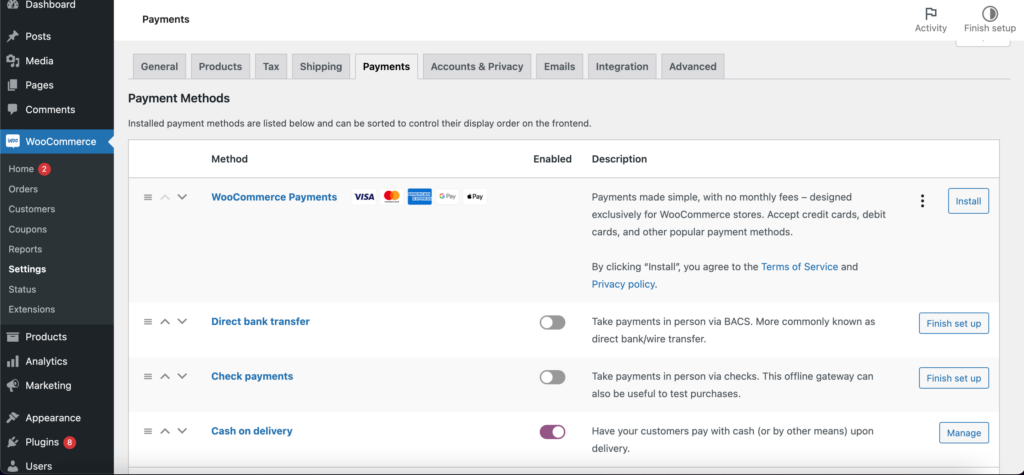
You will find documentation that will help you easily integrate the payment gateways with your online store.
Security & Backup
You are handling customers’ sensitive information like credit card data and personal details. That is why OpenCart and WordPress both are very serious about security.
Also, as you are running a website, it is very normal to run into issues like site breaking, server issues, etc. For that, you need to have a strong backup option.
OpenCart
OpenCart security and backup features are important for protecting your store from unauthorized access and data loss.
Here are the built-in security measures in OpenCart-
- Default password
- Security tokens
- SSL/TLS encryption
- IP address blocking
- Fraud detection.
In addition to the built-in security features, there are also a number of OpenCart extensions that can help you to improve the security of your store.
OpenCart also has site backup features. You can use a built-in backup feature or third-party extension-
- Built-in backup tool: OpenCart includes a built-in backup tool that allows you to back up your store’s database and files.
- Third-party backup extensions: There are also a number of third-party backup extensions available for OpenCart. These extensions can offer a variety of features, such as automated backups, cloud storage, and restore options.
WordPress
WordPress is an open-source platform, so it is more exposed to attacks. WordPress faces attacks at an average of 90,000 attacks per minute.
That is why the WordPress core team releases security patches with every update.
You will find quite a few security plugins in the WordPress repository that will help you keep your site safe. You can use plugins like Wordfence, Security Ninja, Ithemes Security, etc to keep your site protected from hackers.

On the other hand, there is no built-in function for backup in WordPress. You can use plugins like Updraftplus, Sucuri, etc to keep a backup of your website. These plugins are free.
Product & Order Management
Managing products and orders is very crucial for any eCommerce store. If admins face trouble while uploading a product then it will certainly annoy them.
OpenCart and WordPress both have amazing product and order management systems.
OpenCart
You will find various tabs to upload your product in the OpenCart dashboard. You can upload images, add attributes, subscriptions, and discounts, and optimize the product for SEO.

However, you will not find any bulk edit option in OpenCart, so editing more than one product at a time will be difficult.
OpenCart has a built-in order management system that allows you to view and manage all of their orders in one place. The order management system includes a variety of features, such as:
- Order list
- Order details
- Order status updates
- Shipping labels
- Order notifications.
WordPress
WordPress’s (aka WooCommerce’s) product management is very handy as well. You will get all the options like product images, product info, additional info sections, pricing set, custom text, additional product options like variations, etc.
The order management system is very user-friendly as well. You can filter the orders and use the screen options to customize what you want to see in the order section.
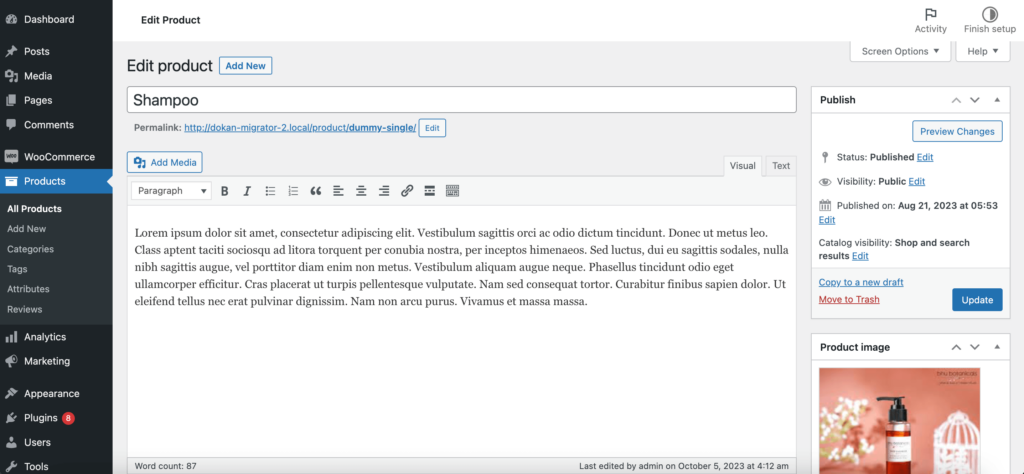
You will be able to see the timestamp and order delivery details for every single order.
Marketing & SEO
In order to promote your eCommerce store and get search engines to notice your site, marketing, and SEO is very crucial.
OpenCart
OpenCart eCommerce platform offers a variety of marketing and SEO features to help you increase your sales and traffic. Here is a brief overview of some of the key marketing and SEO features of OpenCart:
- Marketing features:
- Product discounts and coupons: OpenCart allows store owners to create and manage discounts and coupons for their products.
- Email marketing: OpenCart includes a built-in email marketing tool that allows you to send email newsletters and promotional offers to customers.
- Social media integration: OpenCart integrates with popular social media platforms, such as Facebook, Twitter, and Instagram.
- SEO features:
- Search engine-friendly URLs: OpenCart generates search engine-friendly URLs for products, categories, and other pages on your website.
- Meta tags: The platform allows you to add custom meta tags to your website’s pages.
- Image optimization: OpenCart automatically optimizes your product images for search engines.
In addition to the built-in marketing and SEO features, there are also a number of OpenCart extensions that can help you improve your marketing and SEO efforts.
WordPress
WordPress SEO plugins will enable you to optimize your online store for SEO. You can get all the necessary options for SEO in the free version of those plugins. There are plugins like Yoast SEO, Rankmath, ALL in One SEO, etc to add SEO functionalities to your online store.
There are quite a few social media plugins, and email plugins available that will help you promote your site.
Help and Support
You will need some assistance to get started and help you manage your eCommerce store along the way.
OpenCart and WordPress both excel in that segment.
OpenCart
OpenCart has an extensive support forum and documentation to get you started. The forum is very active and you will get a prompt response. Also, there are third-party developers to help you with customizations.
But if you want you can use their premium support for $99/month.
WordPress
WordPress provides support through documentation, tutorials, and forums. Additionally, many premium themes and plugins offer customer support for product-related issues.
When encountering complex problems, you can contact your hosting provider for assistance.
Pricing
We will talk about the pricing in this part of the WordPress vs OpenCart comparison.
OpenCart
OpenCart is also open-source, so you can download it free from their website and then hire a developer to configure it and design your store. The cost you will pay to get a store ready on OpenCart is more or less the same as WooCommerce; You will need to get a separate hosting provider and install paid themes and extensions.
WordPress
The WordPress core software is FREE to download. However, you need to pay for a domain, hosting, and SSL certificate. However, you will find that most hosting providers will have to bundle these features into one plan.
We will give you a detailed overview of how much it costs to create an eCommerce with both OpenCart and WordPress later in the article.
Cost of Creating an eCommerce Site: OpenCart vs WordPress
Here is the cost of creating an eCommerce website with both OpenCart and WordPress-
| Feature | OpenCart | WordPress |
|---|---|---|
| Platform fee | Free and open-source | Free and open-source |
| Development & Customizations | Can range from $0-$5,000+ | Can range from $500 – $10,000 |
| Domain and Hosting | $10-$20 per year | $5 – $50 per year |
Summary: OpenCart vs WordPress for eCommerce
Here is a detailed summary of OpenCart vs WordPress for eCommerce-
| Feature | OpenCart | WordPress |
|---|---|---|
| Ease of Use | User-friendly, designed for e-commerce. | User-friendly and versatile. |
| eCommerce | Specialized for online stores and product management. | Versatile, can be adapted for e-commerce with plugins like WooCommerce. |
| Customization | Highly customizable for e-commerce needs. | Customizable, but may require additional plugins for e-commerce features. |
| Extensions/Plugins | Offers a wide range of e-commerce extensions, including multivendor support. | Extensive library of plugins for various purposes, including e-commerce. |
| Themes | Themes are available and designed for online stores. | Abundance of themes for different website types, including e-commerce. |
| Security & SEO | Strong focus on e-commerce security. SEO features tailored for online stores. | Security depends on plugins and proper configuration. SEO-friendly, with plugins available for optimization. |
| Multilingual Support & Community and Support | Offers multilingual support out of the box. Active community with a focus on e-commerce. | Multilingual support, may require plugins for advanced functionality. Large community with extensive documentation, including e-commerce support. |
| Multivendor Support | Yes | Yes |
| Scalability | Suitable for small to medium-sized online stores. | Adaptable for small to large online stores, but may require more plugins for scalability. |
| Updates & Maintenance | Regular updates required for security and functionality. | Easier updates and maintenance. |
| Cost | Open-source and free to use. | Open-source and free, but may incur costs for premium themes and plugins. |
| Best Use Case | Small to medium-sized online stores with a focus on e-commerce. | Versatile for a wide range of websites but adaptable for e-commerce projects. |
| Limitations | Limited scalability for extremely large e-commerce projects. Extensions may vary in quality and support. | May require more plugins for advanced e-commerce features, potentially leading to compatibility issues. |
Conclusion
So we are at the end of our article on OpenCart vs WordPress for eCommerce. Now it is time to give our verdict.
You should go for OpenCart over WordPress if you are looking for-
- A dedicated eCommerce platform
- Scalability
- Built-in multivendor support
However, you should go for WordPress over OpenCart if you are looking for-
- Ease of use
- Flexibility
- Reduced cost
- Customization
- Resources
Check more popular comparison posts on WordPress Vs other eCommerce platforms-
Subscribe to
Dokan blog
We send weekly newsletters, no spam for sure!



